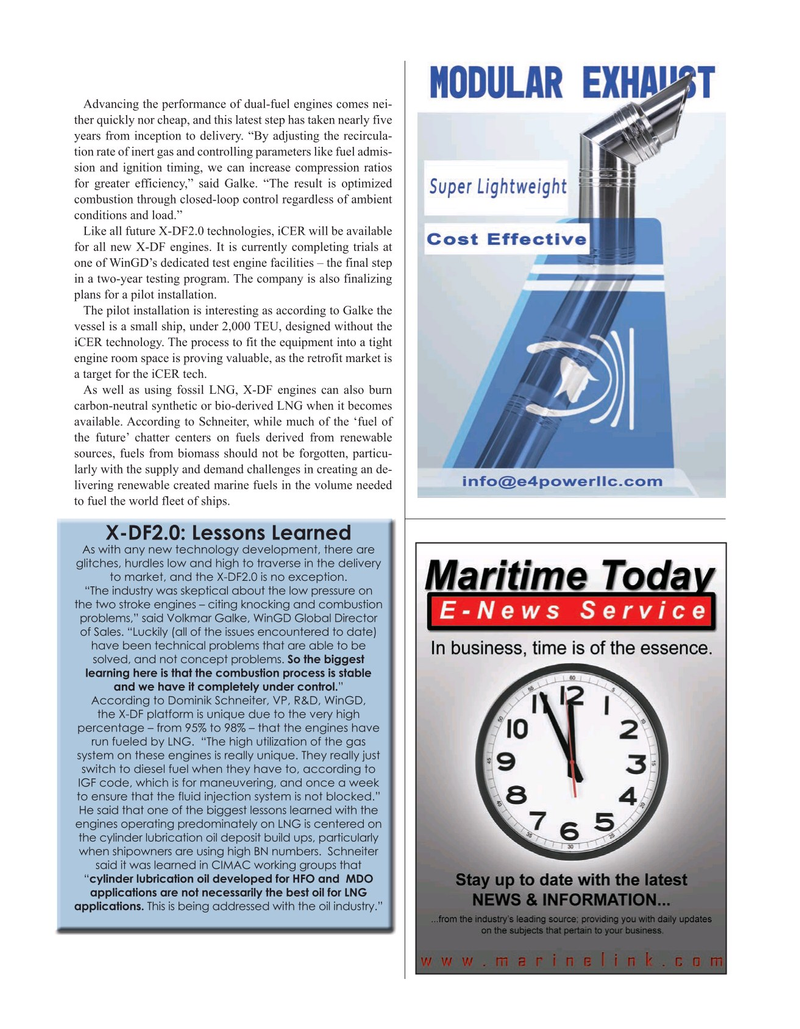
Page 35: of Maritime Reporter Magazine (July 2020)
Maritime Power Edition
Read this page in Pdf, Flash or Html5 edition of July 2020 Maritime Reporter Magazine
Advancing the performance of dual-fuel engines comes nei- ther quickly nor cheap, and this latest step has taken nearly five years from inception to delivery. “By adjusting the recircula- tion rate of inert gas and controlling parameters like fuel admis- sion and ignition timing, we can increase compression ratios for greater efficiency,” said Galke. “The result is optimized combustion through closed-loop control regardless of ambient conditions and load.”
Like all future X-DF2.0 technologies, iCER will be available for all new X-DF engines. It is currently completing trials at one of WinGD’s dedicated test engine facilities – the final step in a two-year testing program. The company is also finalizing plans for a pilot installation.
The pilot installation is interesting as according to Galke the vessel is a small ship, under 2,000 TEU, designed without the iCER technology. The process to fit the equipment into a tight engine room space is proving valuable, as the retrofit market is a target for the iCER tech.
As well as using fossil LNG, X-DF engines can also burn carbon-neutral synthetic or bio-derived LNG when it becomes available. According to Schneiter, while much of the ‘fuel of the future’ chatter centers on fuels derived from renewable sources, fuels from biomass should not be forgotten, particu- larly with the supply and demand challenges in creating an de- livering renewable created marine fuels in the volume needed to fuel the world fleet of ships.
X-DF2.0: Lessons Learned
As with any new technology development, there are glitches, hurdles low and high to traverse in the delivery to market, and the X-DF2.0 is no exception.
“The industry was skeptical about the low pressure on the two stroke engines – citing knocking and combustion problems,” said Volkmar Galke, WinGD Global Director of Sales. “Luckily (all of the issues encountered to date) have been technical problems that are able to be solved, and not concept problems. So the biggest learning here is that the combustion process is stable and we have it completely under control.”
According to Dominik Schneiter, VP, R&D, WinGD, the X-DF platform is unique due to the very high percentage – from 95% to 98% – that the engines have run fueled by LNG. “The high utilization of the gas system on these engines is really unique. They really just switch to diesel fuel when they have to, according to
IGF code, which is for maneuvering, and once a week to ensure that the fluid injection system is not blocked.”
He said that one of the biggest lessons learned with the engines operating predominately on LNG is centered on the cylinder lubrication oil deposit build ups, particularly when shipowners are using high BN numbers. Schneiter said it was learned in CIMAC working groups that “cylinder lubrication oil developed for HFO and MDO applications are not necessarily the best oil for LNG applications. This is being addressed with the oil industry.”

 34
34

 36
36
